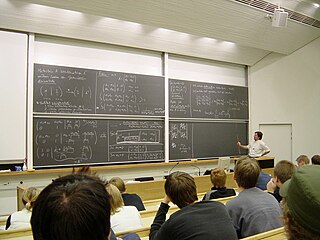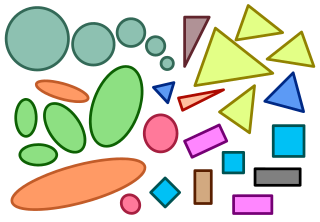In mathematics, an equation is a formula that expresses the equality of two expressions, by connecting them with the equals sign =. The word equation and its cognates in other languages may have subtly different meanings; for example, in French an équation is defined as containing one or more variables, while in English, any well-formed formula consisting of two expressions related with an equals sign is an equation.

Elementary algebra encompasses the basic concepts of algebra. It is often contrasted with arithmetic: arithmetic deals with specified numbers, whilst algebra introduces variables.
First-order logic—also known as predicate logic, quantificational logic, and first-order predicate calculus—is a collection of formal systems used in mathematics, philosophy, linguistics, and computer science. First-order logic uses quantified variables over non-logical objects, and allows the use of sentences that contain variables, so that rather than propositions such as "Socrates is a man", one can have expressions in the form "there exists x such that x is Socrates and x is a man", where "there exists" is a quantifier, while x is a variable. This distinguishes it from propositional logic, which does not use quantifiers or relations; in this sense, propositional logic is the foundation of first-order logic.
A mathematical model is a description of a system using mathematical concepts and language. The process of developing a mathematical model is termed mathematical modeling. Mathematical models are used in the natural sciences and engineering disciplines, as well as in non-physical systems such as the social sciences. The use of mathematical models to solve problems in business or military operations is a large part of the field of operations research. Mathematical models are also used in music, linguistics, and philosophy.
Universal algebra is the field of mathematics that studies algebraic structures themselves, not examples ("models") of algebraic structures. For instance, rather than take particular groups as the object of study, in universal algebra one takes the class of groups as an object of study.

In mathematics, an inequality is a relation which makes a non-equal comparison between two numbers or other mathematical expressions. It is used most often to compare two numbers on the number line by their size. There are several different notations used to represent different kinds of inequalities:
In mathematics, equality is a relationship between two quantities or, more generally two mathematical expressions, asserting that the quantities have the same value, or that the expressions represent the same mathematical object. The equality between A and B is written A = B, and pronounced A equals B. The symbol "=" is called an "equals sign". Two objects that are not equal are said to be distinct.

In contemporary education, mathematics education is the practice of teaching and learning mathematics, along with the associated scholarly research.
In mathematics, a functional equation is, in the broadest meaning, an equation in which one or several functions appear as unknowns. So, differential equations and integral equations are functional equations. However, a more restricted meaning is often used, where a functional equation is an equation that relates several values of the same function. For example, the logarithm functions are essentially characterized by the logarithmic functional equation

Multiple choice (MC), objective response or MCQ is a form of an objective assessment in which respondents are asked to select only correct answers from the choices offered as a list. The multiple choice format is most frequently used in educational testing, in market research, and in elections, when a person chooses between multiple candidates, parties, or policies.

In mathematics, a differential equation is an equation that relates one or more unknown functions and their derivatives. In applications, the functions generally represent physical quantities, the derivatives represent their rates of change, and the differential equation defines a relationship between the two. Such relations are common; therefore, differential equations play a prominent role in many disciplines including engineering, physics, economics, and biology.

Elementary mathematics consists of mathematics topics frequently taught at the primary or secondary school levels.
In mathematics, 0.999... denotes the repeating decimal consisting of an unending sequence of 9s after the decimal point. This repeating decimal represents the smallest number no less than every decimal number in the sequence ; that is, the supremum of this sequence. This number is equal to 1. In other words, "0.999..." is not "almost exactly" or "very, very nearly but not quite" 1 – rather, "0.999..." and "1" represent exactly the same number.
In mathematics, a variable is a symbol and placeholder for any mathematical object. In particular, a variable may represent a number, a vector, a matrix, a function, the argument of a function, a set, or an element of a set.
Algebra can essentially be considered as doing computations similar to those of arithmetic but with non-numerical mathematical objects. However, until the 19th century, algebra consisted essentially of the theory of equations. For example, the fundamental theorem of algebra belongs to the theory of equations and is not, nowadays, considered as belonging to algebra.
Algebra is one of the broad areas of mathematics. Roughly speaking, algebra is the study of mathematical symbols and the rules for manipulating these symbols in formulas; it is a unifying thread of almost all of mathematics.
The Einstein–Infeld–Hoffmann equations of motion, jointly derived by Albert Einstein, Leopold Infeld and Banesh Hoffmann, are the differential equations of motion describing the approximate dynamics of a system of point-like masses due to their mutual gravitational interactions, including general relativistic effects. It uses a first-order post-Newtonian expansion and thus is valid in the limit where the velocities of the bodies are small compared to the speed of light and where the gravitational fields affecting them are correspondingly weak.
In mathematical logic, a formula is satisfiable if it is true under some assignment of values to its variables. For example, the formula is satisfiable because it is true when and , while the formula is not satisfiable over the integers. The dual concept to satisfiability is validity; a formula is valid if every assignment of values to its variables makes the formula true. For example, is valid over the integers, but is not.
In mathematical logic the theory of pure equality is a first-order theory. It has a signature consisting of only the equality relation symbol, and includes no non-logical axioms at all.






